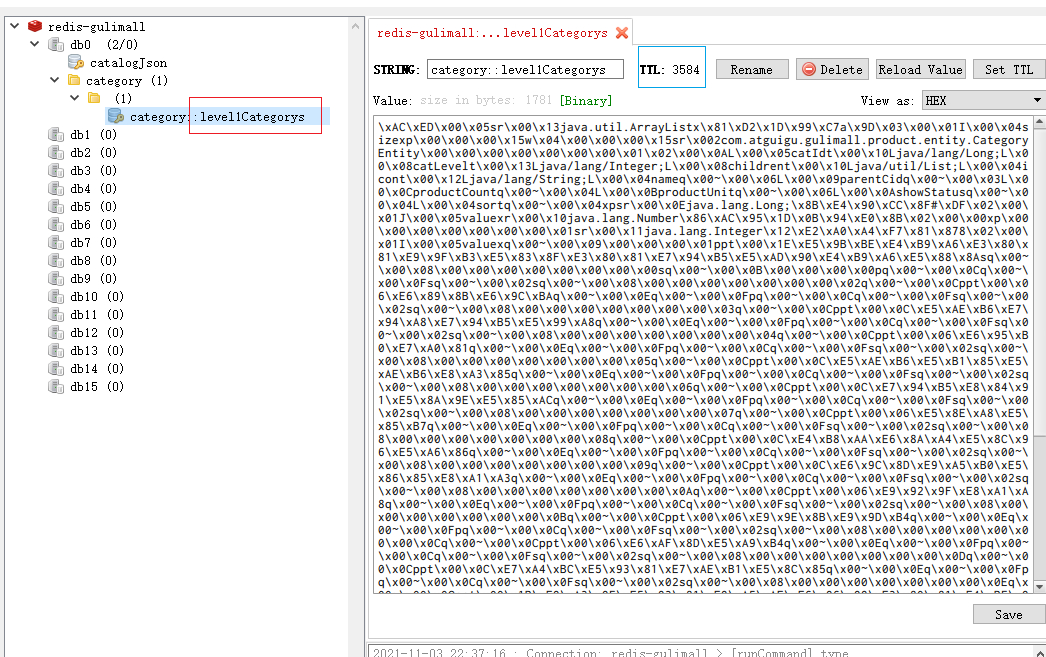SpringCache的简介和使用
1、简介#
Spring 从 3.1 开始定义了 org.springframework.cache.Cache 和 org.springframework.cache.CacheManager 接口来统一不同的缓存技术;
并支持使用 JCache(JSR-107)注解简化我们开发
Cache 接口为缓存的组件规范定义,包含缓存的各种操作集合; Cache 接 口 下 Spring 提 供 了 各 种 xxxCache 的 实 现 ; 如 RedisCache ,
EhCacheCache , ConcurrentMapCache 等;
每次调用需要缓存功能的方法时,Spring 会检查检查指定参数的指定的目标方法是否已经被调用过;如果有就直接从缓存中获取方法
调用后的结果,如果没有就调用方法并缓存结果后返回给用户。下次调用直接从缓存中获取
2、整合SpringCache简化缓存开发#
1)引入依赖#
<dependency>
<groupId>org.springframework.boot</groupId>
<artifactId>spring-boot-starter-cache</artifactId>
</dependency>
2)添加配置#
spring.cache.type=redis
3)测试使用缓存#
@Cacheable 触发将数据保存到缓存的操作 @CacheEvict 将数据从缓存删除 @CachePut 不影响方法执行 更新缓存 @Caching 组合以上多个操作 @CacheConfig 在类级别,共享缓存的相同配置
①、主启动类上添加 @EnableCache注解,开启缓存功能
②、只需要使用注解就可以完成缓存操作
当方法的结果需要缓存到数据库,在方法上加上 @CacheEnable注解
/* 1、每一个需要缓存的数据,我们都要来指定要放到哪个名字的缓存。【相当于缓存的分区(按照业务类型来进行分区)】 2、代表当前方法的结果需要缓存,如果缓存中有,方法不调用;如果缓存中没有,会调用方法,并将方法返回的结果放入缓存 3、默认行为 1)如果缓存中有,方法不能调用 2)key值默认生成,缓存的名字::simplekey [] 3)缓存的value的值默认使用jdk序列化机制,将序列化后的数据存储到redis 4)默认缓存过期时间是-1(用户过期) 自定义: 1)指定缓存生成的key: 指定key-> spel表达式 2)指定缓存的数据的过期时间:配置文件指定 3)将数据保存为json格式: */ @Cacheable("category") @Override public List<CategoryEntity> getLevel1Categorys() { System.out.println("getLevel1Categorys方法执行......"); List<CategoryEntity> categoryEntities = this.baseMapper .selectList(new QueryWrapper<CategoryEntity>().eq("parent_cid", "0")); return categoryEntities; }
第一次访问该方法时,需要访问数据库;第二次访问该方法时,则直接从缓存中获取
③、以自定义的方式设置key的名称和过期时间
@Cacheable(value = {"category"},key="'level1Categorys'")
配置文件中添加
#以毫秒为单位 spring.cache.redis.time-to-live=3600000
④、更多自定义配置
配置key,value的序列化机制:
/** * @author houChen * @date 2021/11/4 6:59 * @Description: * * 缓存配置类 * @ConfigurationProperties(prefix = "spring.cache") : 只是使类中的属性和配置文件绑定,并不能注入到容器中 * */ @EnableConfigurationProperties(CacheProperties.class) //@EnableConfigurationProperties注解 可以使CacheProperties类注入到容器中 @Configuration @EnableCaching public class MyCacheConfig { @Bean RedisCacheConfiguration redisCacheConfiguration(CacheProperties cacheProperties){ RedisCacheConfiguration config = RedisCacheConfiguration.defaultCacheConfig(); config=config.serializeKeysWith(RedisSerializationContext.SerializationPair.fromSerializer(new StringRedisSerializer())); config=config.serializeValuesWith(RedisSerializationContext.SerializationPair.fromSerializer(new GenericJackson2JsonRedisSerializer())); CacheProperties.Redis redisCacheProperties = cacheProperties.getRedis(); if(redisCacheProperties.getTimeToLive()!=null){ config = config.entryTtl(redisCacheProperties.getTimeToLive()); } return config; } }
⑤、使用@CacheEvict (去除缓存)
指定删除某个分区下的所有数据
@CacheEvict(value="category",allEntries=true)
约定:
同一个类型的数据,可以缓存在相同名称的分区中!
3、SpringCache的原理和不足#
1)读模式#
缓存穿透:查询一个null数据。解决:缓存空数据:cache-null-values=true
缓存击穿:大量并发请求进来同时查询一个正好过期的数据。 解决: 加锁
缓存雪崩:大量的key同时过期 解决:加随机时间
2)写模式 (如何保证缓存和数据库一致性)#
1)加锁模式
2)引入canal






【推荐】国内首个AI IDE,深度理解中文开发场景,立即下载体验Trae
【推荐】编程新体验,更懂你的AI,立即体验豆包MarsCode编程助手
【推荐】抖音旗下AI助手豆包,你的智能百科全书,全免费不限次数
【推荐】轻量又高性能的 SSH 工具 IShell:AI 加持,快人一步
· 从 HTTP 原因短语缺失研究 HTTP/2 和 HTTP/3 的设计差异
· AI与.NET技术实操系列:向量存储与相似性搜索在 .NET 中的实现
· 基于Microsoft.Extensions.AI核心库实现RAG应用
· Linux系列:如何用heaptrack跟踪.NET程序的非托管内存泄露
· 开发者必知的日志记录最佳实践
· TypeScript + Deepseek 打造卜卦网站:技术与玄学的结合
· Manus的开源复刻OpenManus初探
· AI 智能体引爆开源社区「GitHub 热点速览」
· 三行代码完成国际化适配,妙~啊~
· .NET Core 中如何实现缓存的预热?